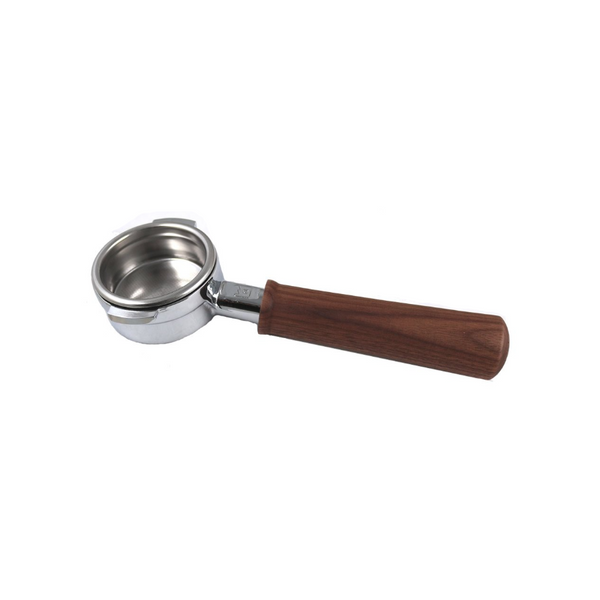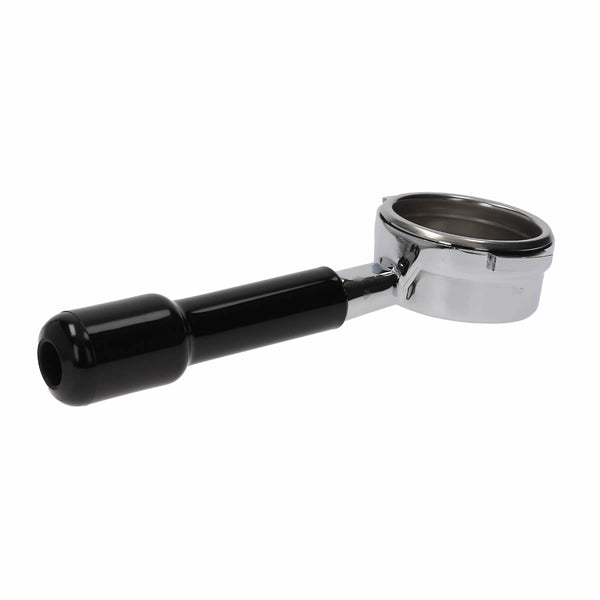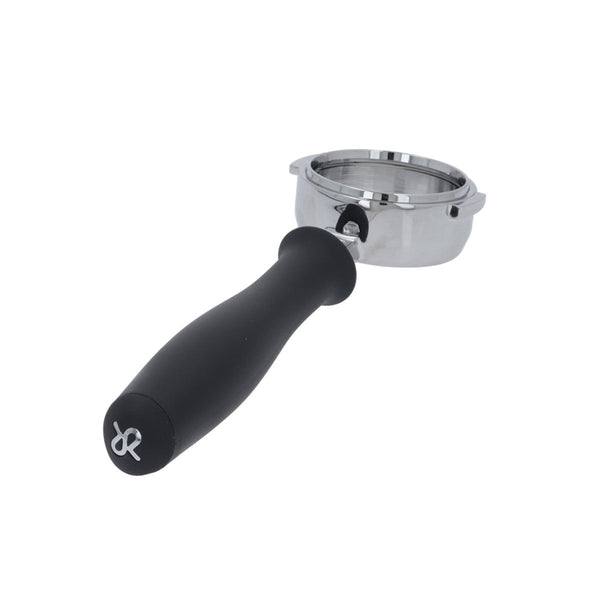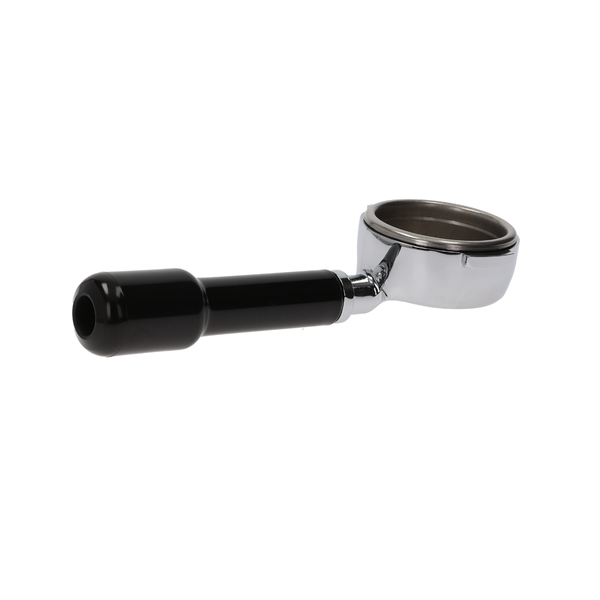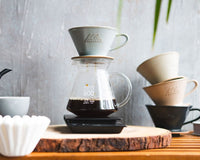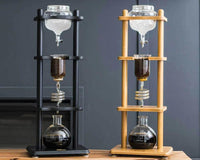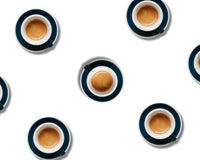A Barista’s Guide to Better Espresso
A bottomless portafilter, or a naked portafilter, is a specialized espresso tool that allows baristas to visually monitor espresso extraction. Unlike standard portafilters, it has no spouts, revealing the entire basket and flow of the shot. This makes it ideal for training, troubleshooting, and improving shot quality.
Anatomy of a Portafilter (and What’s Missing in a Bottomless One)
To appreciate how bottomless portafilters work, it’s helpful to know the key parts of any portafilter:
- Handle – For gripping and locking into the espresso machine
- Filter Basket – Holds the coffee grounds
- Spring Clip – Secures the basket in place
- Body – Made of stainless steel or brass to retain heat
- Spout(s) – Direct espresso into cups (absent in bottomless models)
Bottomless portafilters expose the bottom of the filter basket, removing the spouts entirely.
Types of Espresso Portafilters: Where Bottomless Fits In
There are several types of portafilters, each with a specific use:
|
Type |
Description |
Best For |
|
Spouted |
Standard with one or two spouts |
Cafés & clean service |
|
Bottomless (Naked) |
No spouts; full view of extraction |
Training, quality control, photography, videography |
|
Pressurized |
Built-in pressure to aid extraction, always spouted |
Beginners with entry-level machines |
|
Non-Pressurized |
Requires grind/tamp control |
Professional setups |
|
Pod-Compatible |
Designed for ESE pods |
Convenience-focused use |
While bottomless portafilters are advanced tools, they’re most effective when used by baristas with a solid understanding of espresso fundamentals.
Why Use a Bottomless Portafilter?
5 Evidence-Based Benefits for Baristas and Coffee Enthusiasts
1. Improve Shot Consistency
Instant shot troubleshooting takes the guesswork out of dialing in, so your team can focus on what they love: serving coffee that consistently hits the mark. With real-time visibility, baristas can spot channeling, uneven tamping, or signs of over- and under-extraction right away. That quick feedback leads to greater consistency in cup quality, which is a huge win for high-volume cafés where multiple baristas share the bar.
And consistency isn’t just good for operations. It builds trust with your customers, keeps them coming back, and gives your café a clear edge in a competitive industry.
Pro Insight: According to one barista trainer: “Bottomless portafilters reveal mistakes that standard spouted models hide.”
2. Maximize Crema Production
With no obstruction or contact from spouts, crema develops naturally, resulting in a richer, thicker layer that enhances both flavor and presentation. In the hands of an experienced barista using fresh beans, a bottomless portafilter produces noticeably more crema, since the espresso only touches the bottom of the basket and not spouts or threads. That keeps the delicate crema bubbles intact and the flavor at its best.
Removing the spout also provides extra cup clearance, allowing you to pull shots directly into the serving cup in most cases. For most to-go cups, you’ll still need a shot glass under the portafilter, but for standard in-house cups and mugs, bottomless is as straightforward as it gets
Why it matters: Crema acts as a flavor carrier. A thicker crema layer often means a fresher, more balanced espresso.
3. Better Taste and Easy Cleaning
Better flavor starts with a clean portafilter. Bottomless portafilters eliminate residual build-up of coffee oils and loose coffee ground particulate in the spout and splitter pathway. They also encourage easy cleaning between shots, preserving coffee's bright flavor.
4. Essential for Espresso Troubleshooting
Want to know if your tamping angle is off or your grind is uneven? A bottomless portafilter lets the barista to instantly deduce if they've tamped evenly. If the extraction leans to one side or the other, then you likely used an improper angle when tamping. If rogue streams of espresso start spraying every which way from the bottom of the basket, it's possible that your portafilter was leveled and or dosed unevenly.
5. A Powerful Training Tool
Bottomless portafilters have quickly become a favorite training tool among baristas at home and in the café. They help cafés trainers teach shot diagnostics, grind adjustments, and dose distribution techniques. Beginner baristas learn faster when they can see exactly what’s happening beneath the basket.
Nothing beats visual feedback. A bottomless portafilter shortens the learning curve.

How Bottomless Portafilters Improve Espresso Quality and Skills
Understanding portafilters — how they’re built, what types exist, and why bottomless models are used — equips you with more than technical knowledge. It gives you control over your espresso. Whether you're a home barista or a café pro, choosing the right portafilter helps you:
- Diagnose problems more easily
- Extract better-tasting shots
- Develop seasoned-barista-level skills
A bottomless portafilter isn’t just a trend; it’s a teaching tool, a quality control device, and a taste enhancer all in one.
Bottomless Portafilter FAQs: Fit, Function, and Results
Do bottomless portafilters fit all machines?
No. Be sure to match the diameter (commonly 54mm or 58mm) with your espresso machine's group.
Will using a naked portafilter improve my espresso?
Yes, if paired with proper technique, grind size, and dose control. It won’t fix poor habits, but it will make flaws visible.
What is the difference between bottomless and spouted portafilters?
A bottomless portafilter has no spouts and exposes the basket, letting espresso flow freely. A spouted portafilter splits the shot into one, two, and sometimes even three streams. The bottomless design is ideal for training and quality control, while spouted ones are better for clean service and dual-shot use.
What causes a bottomless portafilter to spray?
A bottomless portafilter sprays when channeling occurs; this means water is finding weak or uneven paths through the coffee puck. The most common causes are uneven tamping, inconsistent grind distribution, or over/under-dosing. Spraying is a sign that extraction isn't uniform, making the bottomless portafilter a valuable tool for diagnosing technique flaws.


